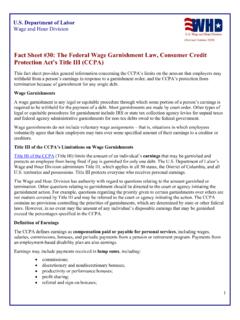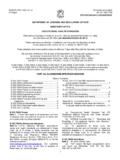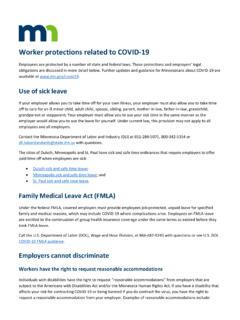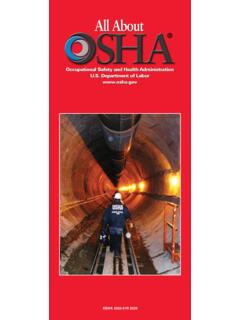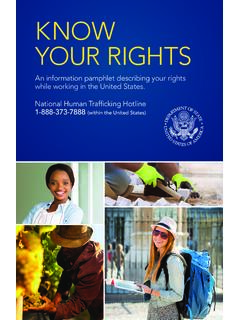Transcription of Temporary Worker Initiative - Occupational Safety and ...
1 TWI BULLETIN NO. 4 Temporary Worker InitiativeSafety and Health Training This is part of a series of guidance documents developed under the Occupational Safety and Health Administration s (OSHA s) Temporary Worker Initiative (TWI). This Initiative focuses on compliance with Safety and health requirements when Temporary workers are employed under the joint employment of a staffing agency and a host workers are entitled to the same protections under the Occupational Safety and Health Act of 1970 (the OSH Act) as all other covered workers. When a staffing agency supplies Temporary workers to a business, typically, the staffing agency and the staffing agency s client, commonly referred to as the host employer, are joint employers of those workers. Both employers are responsible to some degree for determining the conditions of employment and complying with the law. In these joint employment situations, questions regarding how each employer can fulfill their duty to comply with the standard are common.
2 This bulletin addresses what both the staffing agency and the host employer can do to provide Safety and health training to Temporary workers. Many OSHA standards include specific Safety and health training requirements to ensure that workers have the required skills and knowledge to safely perform their work. These requirements reflect OSHA s principle that training is an essential part of an effective Safety and health management program for protecting workers from injuries and illnesses. Many fatal incidents have occurred where Temporary workers were not provided the training necessary to do their job of Temporary WorkersThe staffing agency and the host employer share the responsibility for training Temporary workers. Training must be completed before the Worker begins work on a project and the training must be in a language and vocabulary the Worker understands. Depending on the industry, worksite, and job duties to which the Temporary Worker is assigned, certain OSHA standards which require both generic and specific training may be applicable.
3 While both the host and the staffing agency are responsible to ensure that the employee is properly trained according to the applicable standard, the employers may decide that a division of the responsibility may be appropriate. As a recommended practice, the staffing agency and host employer should establish which party is responsible for each aspect of training, as well as inform the other employer when training is completed. The details of the training to be performed can be clearly stated in the language of the contract between the employers. However, neither employer may avoid their ultimate responsibilities under the OSH Act by requiring another party to perform most cases, the host employer is responsible for site-specific training and the staffing agency is responsible for generic Safety and health training. It is the responsibility of both the staffing agency and the host employer to review applicable OSHA standards, know the specific training requirements, and determine and agree upon the generic Safety training requirements that the staffing agency will provide to Temporary workers and the site-specific training requirements that the host employer will provide.
4 The training goal is to ensure that workers know how to do their work safely, can identify hazards, and understand control and protective measures. Under OSHA s Recordkeeping Requirement both the staffing agency and the host employer are responsible for ensuring that the Temporary employees are involved in the recordkeeping system by training Temporary employees on the reporting process for all work-related injuries or illnesses and setting up a system for the Temporary workers to report work-related injuries and illnesses promptly. See 29 CFR (b). The employer that supervises employees on a day-to-day basis (usually the host employer) must record the work-related injuries and illnesses of the Temporary workers. See 29 CFR (b)(2). If the staffing agency is not the employer responsible for recording the work-related injuries or illnesses, the staffing agency should implement a mechanism for the Temporary employees to report incidents to the staffing agency.
5 Neither the host employer nor the staffing agency should have any policies or programs that discourage the reporting of injuries, illnesses, or hazards. Host Employer ResponsibilitiesThe host employer is usually responsible for site-specific training because it is often in the best position to provide such training. The host employer generally controls the details, means, methods and processes by which the work is to be accomplished. In addition, the host employer is most familiar with the hazards of the specific job tasks, machinery, equipment, and processes of its worksite and understands the training necessary to protect workers from those specific hazards. Staffing Agency ResponsibilitiesThe staffing agency is usually responsible for providing generic Safety and health training so that its workers have a basic ability to identify hazardous situations, report hazards, injuries and illnesses, and understand their rights if confronted with a hazardous situation at a worksite.
6 The staffing agency is responsible for ensuring that employees receive proper site-specific training. In order to fulfill this obligation, the staffing agency must have a reasonable basis for believing that the host employer s training adequately addresses the potential hazards to which employees will be exposed at the host employer s worksite. If the staffing agency has reason to believe the site-specific training is not adequate, it should inform the host employer and collaboratively determine and provide adequate training, provide the training itself, or remove its workers from the host employer s worksite. While the staffing agency may have a representative at the host employer s worksite, the presence of that representative does not transfer responsibilities for site-specific training to the staffing agency. The staffing agency may agree to provide site-specific training if it is familiar with the hazards of the worksite.
7 The staffing agency may choose to conduct a walkthrough of the worksite to identify tasks that Temporary employees will perform and the hazards of those tasks. However, the employer originally responsible for the particular training (determined by supervision and control over the workers and hazards) must still ensure that the workers complete the training and that the training is adequate before work begins. 3 Example Scenarios*The examples provided below are fictitious but describe what often happens when Temporary workers are not adequately trained for their job assignments by the staffing agencies and host employers. Construction ScenarioRemediation and Construction, LLC (RAC) is a company that remediates damaged commercial and residential structures. They need additional skilled roofers to complete a commercial remediation project in Alaska. RAC contracts with Temp Staffing to provide unskilled laborers on a Temporary basis to complete the job on time because unskilled laborers are less expensive than skilled roofers.
8 Temp Staffing did not determine the type of work these workers would be doing and just provided generic Safety and health training for the workers before sending them to RAC s worksite. At the RAC worksite, a RAC foreman assigned three of the Temporary workers to work on the roof. For several days, the workers remove roofing material on top of a sheet metal roof of a fire-damaged building. The work location is approximately 13 feet above the ground. RAC did not mention to Temp Staffing that the Temporary workers would be used as roofers and did not mention that the workers would need fall protection training or any other jobsite-specific training. The Temporary workers convey their concerns to the RAC foreman regarding the lack of fall protection and training while working on the fire-damaged roof. The foreman takes no action to provide fall protection or fall protection training. Construction AnalysisRAC requested unskilled laborers instead of skilled roofers to complete the job.
9 Therefore, RAC had no reason to believe the workers had received fall protection training. RAC was in the best position to provide the jobsite-specific training. Since RAC should have known from the start of the project that the workers did not have fall protection training, and the RAC foreman found out during the course of the project that the workers had not received fall protection training, RAC was responsible for identifying the need for fall protection training and providing the training under 29 CFR Training requirements. RAC supervised and controlled the day-to-day work of the Temporary workers at its worksite. For this failure to provide appropriate site-specific training, RAC may be subject to an OSHA most cases, the Temporary agency is responsible for generic Safety and health training. Although Temp Staffing provided such generic training, it also had a responsibility to determine what its workers would be doing and the hazards to which they would be exposed in order to ensure that site-specific training was provided and completed.
10 Temp Staffing failed to fulfill this responsibility when it made no effort to determine what kind of work the workers would be performing or if RAC had provided the necessary training. For failure to ensure that appropriate site-specific training was provided, Temp Staffing may also be subject to an OSHA citation related to fall protection training requirements.*The company names in this scenario are fictitious. Any resemblance to real companies is entirely coincidental. 4 General Industry ScenarioA metal equipment manufacturer, Iron Alloys Co. (IAC), needs machine operators for a short-term increase in production. The company contracts with a staffing agency, Temp Staffing, to provide workers. Temp Staffing hires ten Temporary workers as power press operators and sends them to work on site at IAC. The staffing agency also hires a person to act as the Temporary workers team leader who will communicate the host employer s orders and any provided site-specific training.










